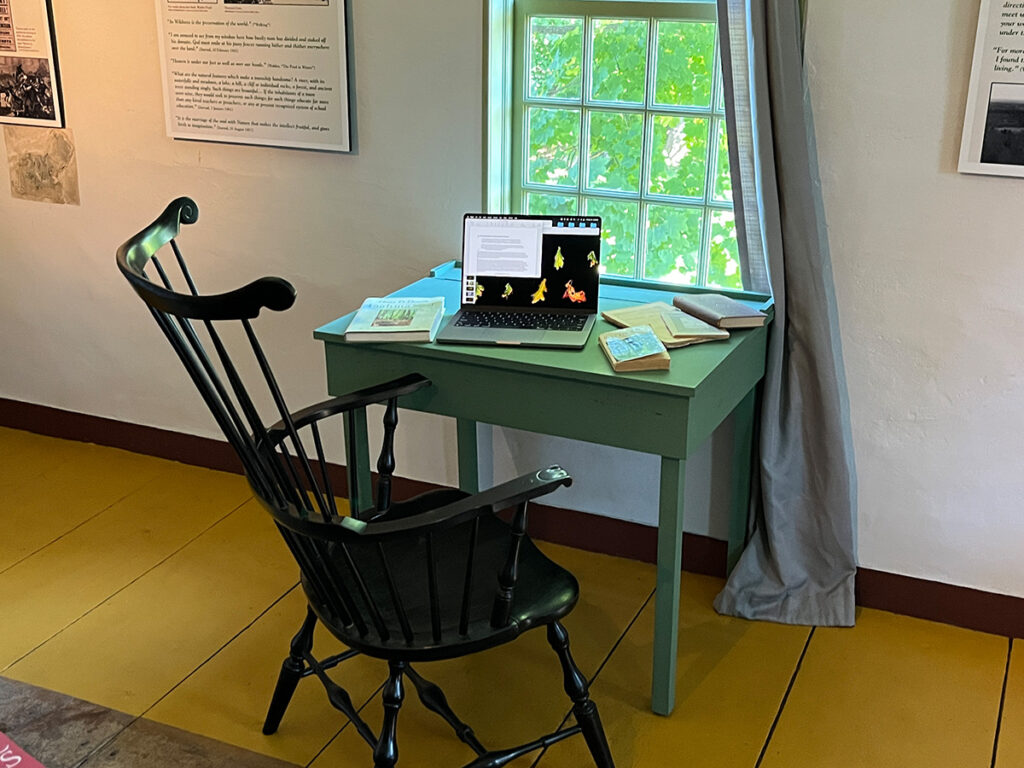“I left the woods for as good a reason as I went there. Perhaps it seemed to me that I had several more lives to live, and could not spare any more time for that one.”
–Henry David Thoreau
Thoreau Farm
The current book project, Munsell Trees: A Season of Leaves and Colors, includes a chapter on the inspiration of Henry David Thoreau. In writing that chapter, two decisions were made. First it would be written in a single day (though the outline was refined for some time previously) and it would be written in the birth room at Thoreau Farm in Concord, MA, which has been refurbished into a writer’s retreat. The day came in mid-September and the results exceeded expectations. Of course, the success of the chapter is for others, future readers, to decide, but the clarity of what and how to write came quickly and effortlessly in the Thoreau-inspired surroundings. The computer was setup on a replica of Henry’s writing desk from his cabin at Walden Pond — with the exception that the top was constructed to be flat instead of tilted to accommodate modern laptops users instead on pencil and paper. Antique printings of several of henry’s books and essays were brought along both for reference and inspiration. A lunch was packed, and the day began early, before the dawn, with a walk through Sleepy Hollow Cemetery to visit Thoreau’s gravesite on author’s ridge. After that, the retreat started in the lovely surrounds of the farm, within the room where Henry was born in the early 1800s.
The inspiration was true, and accurate, and writing felt easy as I imagine it came to Thoreau in his normal state of retreat and clarity of mind. It was wonderful to create such a state, if even for a day and a goal will be to recreate it, even in the remaining post-sabbatical years at the university.

Writing Like Painting
Not being a painter, one can only imagine the witnessed process of completing a painted work. Being on sabbatical, and having permanently given up all administrative responsibilities is a source of true enlightenment. Writing previously had been mostly a time-constrained, linear process. After creating an outline, a time block was found large enough to accommodate writing the entire piece (paper, chapter, what-have-you). The process was done carefully so that the first draft was essentially the final draft — only time for minor edits and corrections before submission. This has been admittedly productive and successful, but now, with focus and clarity of thought, the process has evolved into something entirely different.
Writing is now done in short and intermittent sessions when the mood strikes. A broad base-layer is laid down; first with the outline and then with random thoughts that pop up and fit in various places. These range from more outline, to images, to fully formed paragraphs. This process is repeated several times until the work is filled out with paragraphs. One final linear pass and the first draft is done. Then the editorial process sometimes takes on several iterations at random times. There is no rush; there are no deadlines.
The random ordering of work is the most novel aspect and troubling at first. However, the time and clarity to do careful edits of the finished work obviates that problem and results in a better finished result. Having time to think has turned on the lights. The same is true for meditation, it is now a constant process instead of something squeezed into small available chunks of time. The lights are always on.
Peace.
Next up; Philosophical Taoism